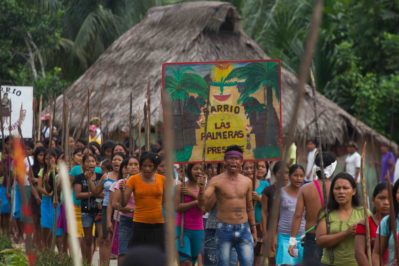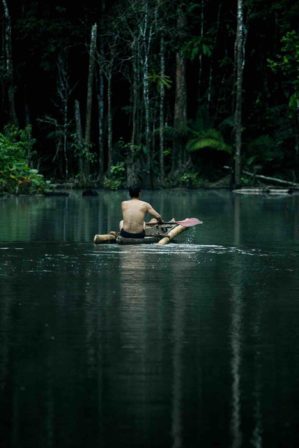INTERVIEW: New documentary explores Amazonian conflict in Peru

When Two Worlds Collide, which recently premiered at Film Forum in New York City, is a documentary that follows the clash of corporate and indigenous interests in Peru’s portion of the Amazon. On one side of the debate is former President Alan García, who is seen entering into a trade agreement with the United States and championing new laws that would aid development. On the other side of the debate is Alberto Pizango, leader of Peru’s Amazonian people and the public face of the protests that rocked the nation several years ago.
At its heart, the documentary explores the universal theme of what happens when corporate interests and indigenous interests don’t match up. In Peru, the protests turned deadly, leaving several police officials and indigenous people dead, and many people wondering what happened and why. Politicians in the film bicker back and forth. Pizango eventually flees the country and seeks asylum in Nicaragua, and the repercussions are still felt today.
The film tracks the events over several years, meaning the audience receives, in less than two hours, a summarized version of Peru’s recent history. The team behind the documentary includes directors Heidi Brandenburg and Mathew Orzel, and producer Taira Akbar. All three will be in attendance at Film Forum for question-and-answer sessions Friday, Aug. 19 at 7:40 p.m. and Saturday, Aug. 20 at 3 p.m.
“I studied with Heidi back at university, and we did a few short films together,” Orzel said recently in a joint phone interview. “And we really wanted to start the search for another film project, and at the time we also started to collaborate with our close friend, Taira Akbar, who was working for the BBC at the time. Heidi is half-Peruvian, and her first film was based in Peru. I think we were all really inspired by that, and … it made sense to go back to Peru and look for a story. Heidi’s family are based there, and so it kind of gave us a good setup to go and explore.”
Brandenburg said they had arrived in the country at a time when the free trade agreement with the United States had built up tension among the communities in the rainforest because of possible contamination of the land and loss of their ancestral way of life. Scenes in When Two Worlds Collide show a section of the rainforest drenched in oil, with the black ooze dripping from trees and wreaking havoc on the environment. This startling scene is what the Amazonian people wanted to stop before it was too late, and thus the protest movement over the trade agreement and new laws in the country was born.
“[We] wondered what’s going to happen after the free-trade agreement once it gets signed, and it was a good question because shortly after the agreement was signed, García brought out these laws that were basically opening up the rainforest for private investment, agriculture development,” Brandenburg said. “And that’s cause for a huge opposition and uproar by the indigenous people and NGOs, and that sort of pushed us to find out what was really happening in Peru.”
Orzel said that the news coverage at the time was mainly focused on the political battles. Their team wanted to break from the governmental offices in Lima, the nation’s capital, and head into the Amazon to document the sentiments of the people most affected by the new laws. “We realized a lot of the media was focused on the politics behind what was causing the problem but not really understanding why,” he said. “And we really wanted to go deep into the Amazon and find out from the people that are closest to nature, find out from their point of view why they wanted to protest against the law.”

The documentary team started researching the story at the end of 2007. Soon enough they headed for the Amazon to gain the trust of the local communities.
“We tried to travel through different parts of the rainforest, which was an incredible challenge because outsiders like us — and I’m not even an outsider, I was raised in Peru — it was very difficult to build a relationship,” Brandenburg said. “You had to establish a relationship … through an NGO, who would then put you in touch with the indigenous federation, which is like an organization, depending which part of the Amazon you want to travel to. And then you have to ask for permission, so it was a long process. And often NGOs weren’t even willing to take us. Sometimes we went anyhow, and then we were left at the port in the middle of the jungle and weren’t even taken to the community because they then said, ‘Well, you know, now it’s too risky for us because they might think you’re a spy, or they might think you want to exploit them with a story like many other journalists.’ Often we just had to return back to Lima and start all over again, so it was a long process.”
After gaining trust and making inroads in the Amazon, the documentary team realized that the planned development of this precious part of the country was not in the interests of the local people. Brandenburg called it development that would cut right into their fabric, their way of life.
The next obstacle was to find someone that could tell the story on a more personal, intimate scale. That’s when they met Pizango, a controversial figure whose legal fate is documented in When Two Worlds Collide. “Getting his trust wasn’t easy,” Brandenburg said. “We had a lot of questions to answer before we got to understand what they were really going through and how to present it from their point of view.”
Akbar said a lot of the footage in the film is archival from a variety of sources; however, not every news agency was forthcoming with the material. They also received on-the-ground films from the protests, which eventually turned violent, and from inside Pizango’s headquarters in Lima. “We have about 25 minutes, which we got from several people from police officers, from indigenous people, from local channels, from national channels, from local cameramen, and that also took us years to get,” Akbar said. “And the footage that you see of the protests, it was being filmed on the day by local cameramen, by even international NGOs that had gone in and sent camera people.”
When the protests occurred, tensions were rising, especially in Bagua, Peru. A blockade of an oil plant and highway became the flash points in the clash between police officials and the Amazonian people, and the aftermath was quite deadly. Scenes in the film show injuries and death on both sides, and a general sense of disarray and confusion.
The documentary team was able to film interviews with most of the stakeholders. They talked to members of Congress, other government officials, Pizango and the indigenous communities. One scene, in particular, follows the father of a missing police officer. He’s a person who simply wants to know what happened to his son during the violent clashes, and he begs the protestors and government to provide some answers.
The story of these protests stretches beyond Peru. Increasingly, environmental and cultural interests are at odds with corporate interests. The team sees this battle continuing. “I think this is one of the reasons why we made this film was to highlight this problem and really continue the conversation or contribute to the ongoing conversation about the Amazon and how we need to look at solutions and prevent these types of conflicts,” Orzel said. “And also within When Two Worlds Collide, you really get close to the characters that were affected by this and not just indigenous people but people from the city, and I think people can really connect with these traumatic experiences these families have been through.”
Brandenburg added: “One of the biggest problems is the way the economic system is set and the way that indigenous rights are not as dominant as corporate rights, and there’s no balance between those. So they’re going to keep on clashing as long as we need to extract from natural resources because unfortunately corporate rights will always go over indigenous or human rights. That’s the way we see it, and I think that’s one of the big problems right there.”
The film recently played the Lima Film Festival, and the response was a positive one from the Peruvian crowd. “We were quite relieved in some ways,” Orzel said. “We didn’t really know how people were going to take to the film, and it’s really, really emotional. We managed to capture unfortunately a very tragic moment in Peruvian history, and it’s an intense film. And we show it as it happens, and there’s a lot of moments that people are not aware of. People came up to us, thanked us, and, yeah, they said there’s a lot of in the film they didn’t know. So we’re very happy.”
By John Soltes / Publisher / John@HollywoodSoapbox.com
When Two Worlds Collide is currently playing the Film Forum in New York City. Click here for more information.

